Similar Posts
I am not an icon writer nor am I an icon painter, if it makes a difference. I am the founder and administrator of the non-profit organization Hexaemeron which sponsors courses in iconography. As such, I once attempted to make a St. Paul icon to familiarize myself with the process so that I could write about it. Like every student who takes our classes, my teachers did not allow me to fail.
At some point during my lessons, I asked one of our teachers, Anna Gouriev, why she and the other teachers spend so much time helping students carry out their work. “Wouldn’t it be better to let the image that evolves stand on its own? Would it not be more genuinely theirs? ”
Anna is not an art therapist. In her matter-of-fact way she simply said, “It’s not theirs. Icons must be beautiful and truthful; we can’t be negligent.”
What does it mean, “Icons must be beautiful and truthful?”
We often refer to something as being beautiful without criteria other than the subjective pleasure it gives us. Because our language has become thin, especially as it relates to art, beauty no longer has a definite meaning. It seems odd to speak of beauty, much less truth, as a necessity in making something.
Anna is Russian; we forgive her for ignoring our taboos. She knows the criteria for beauty and truth in icons. She learned it from her mother, Ksenia Mihailovna Pokrovskaya, who learned it from spending years before some of the highest examples of iconography in the museums and churches of Moscow. And, from her hours spent practicing what she learned by studying how the great masters of icon painting worked. She has been at it for more than forty years.
The same applies to teaching iconography. Making something “beautiful” and “truthful” must be learned with great effort, and the most direct tutor is that of watching the movements of a master. Our courses last only six days. Even with the guidance of our teaching team of Ksenia, Anna and Marek Czarnecki, the expectation that making an icon can be learned in such a brief period is destined for failure. Hexaemeron‘s method of instruction in this compressed time frame is dependent upon students watching while their work is corrected.
The notion of “correcting” goes against the dogma of individual sovereignty in expression that has been prevalent in modern art for at least a century. Generally, this is not an objection for our students whose interest in iconography lies outside the mainstream of contemporary art. And generally, even our art school survivors understand that the constraints of the icon are its freedom as well as its genius.
With a few basic line structures, the face is established with an intimacy that a photograph cannot convey. It is a “truthful” depiction more than an artistic or mechanical one, which is why Ksenia can shockingly say, “The icon is not art and it is not a picture.” I have heard her repeat this statement in every course we offer and it is possibly the most difficult concept for our students to understand. Whether a picture is a blink of time captured by the camera shutter or a handmade art object, it is a construct of the artist’s visualization that is created to be observed. The icon has a different purpose. The icon is created to initiate and sustain a timeless conversation between the person represented in the image and the person who beholds it.
Sometimes, when I walk among the tables of students bent from the waist over their projects with eyes inches from where their brushes meet the surface of the panel, I glimpse something so arresting that I have to stop and say, “This is beautiful!” While I focus my camera lens on the image emerging from the practice panel, the student almost guiltily pushes back from the table and smiles. “Anna helped me.” Or “Marek helped me.” Or “Ksenia helped me.”
Of course!
In the beginning the work can be torturous for the student. Some may wish they had chosen an art therapy class with a Byzantine theme. It is frustrating to scrape off the layers down to the gesso and start again. But our teachers are less interested in their students’ emotional experience of the process than in guiding them through it to worthy results. Because of the icon’s liturgical importance, Ksenia, Anna and Marek involve themselves in every stage of the process to ensure the faithfulness of the product.
Before class begins, work tables are covered with white paper to protect them from damage. The blank surface provides demonstration areas for the teachers to engage the work of each student, side by side. It also becomes a practice space for students to pre-test their strokes. By the third day, when images on project boards begin to develop toward completion, the table covers are crowded with color trials, brush rehearsals and Ksenia quotes.
Ksenia uses photographs clipped from fashion magazines and news articles to demonstrate the icon’s anatomic accuracy. On a sheet of clear acetate, she traces the outline of the skull, ears, eyes and nose in a photo-example and places the drawing over an icon reproduction. She does this to show how the icon presents the human face precisely though not naturalistically. Rather than receding in scale toward an implied horizon in one point perspective, every feature of the face, as well as the architectural and landscape elements, expands toward the viewer. As Ksenia explains, the dynamics of “reverse perspective” thrust the invisible into the visible domain so as to welcome a dialogue between heaven and earth.
Garments and hair are among the most difficult elements of the icon to manage and require special attention. Just as in a figure-painting studio; someone in the class may be drafted to serve as a drapery hanger while Ksenia connects the icon’s treatment of apparel with life. She arranges her magazine clippings on the overhead projector to illustrate the behavior of hair and beards. Great care is taken to make students aware that these details are always orderly and never convoluted, not even in those of wilderness dwellers such as Sts. John the Forerunner, Mary of Egypt and Anthony.
The more advanced the student, the more keenly he is aware of being watched and appreciates the oversight of teachers. Something beautiful takes place. Like practicing the runs of a musical score, the student of iconography begins to fine-tune the brush instrument. The hand starts to play the graphic melody with the freedom of faithfulness, not imagination.
Ksenia constantly reminds her students that “the icon is not the artist’s vision; it is the vision of the Church.“ Without accepting this fundamental understanding, the result can be a bastard of the icon. Images that have nothing to do with hagiography have been stylized with an iconesque aura to serve a broad range of social and political purposes. Even with positive desire to render a glorified subject, limited training and skill often produces a clownish imitation of primitivism where anything with two eyes, a nose and a nimbus passes for an icon. As Marek says, “Sloppiness in the egg-tempera medium produces an omelet”.
The opposite comes through as religious portraiture in iconic poses where feats of artistic naturalism are displayed. Going forward with exiting photographs of new martyrs and the recently glorified, an exploratory tension between intentional primitivism and naturalism is almost inevitable as iconographers struggle with how to describe the transfigured glory of Christian heroes. Creating prototypes for Sts. John of Kronstadt and John of Shanghai and San Francisco are examples of this experimentation. But so is the attempt to establish sincere prototypes for western saints whose representations have been popularized in sentimental paintings or appear only in pious literature.
“Spiritual realism” is what Ksenia calls the defining character of iconography, not as an art form but as a grammar that uses the tools of art for its alphabet. Spiritual realism contains information observable in nature, but translates it into the language of deification. It must be a careful translation, aesthetically adequate and semantically valid for liturgical use. The principles of spiritual realism underpin every lesson and guide every “correction“ toward the goal of our courses. That is, to train students how to enter into the tradition that sets the icon apart as a discipline for portraying heavenly citizenship.
The finished work that students take home becomes a personal laboratory or library that can be entered at any time in order to practice the skills he or she has sharpened by watching, working and receiving correction. My icon of St. Paul turned out beautifully. It has a place in my laboratory where I practice the skills of a believer, not those of an icon writer or painter. Ksenia, Marek and Anna’s hands are anonymously there. I stand gratefully corrected.
For our students’ work to be truthful, it must express the beauty of Orthodox Theology in images that can be clearly read. For it to be beautiful, the work must declare our salvation with the aesthetic majesty appropriate to Our Savior’s accomplishment. Though this is the aim of our instruction, it is impossible to guarantee.
Yet, we cannot allow our students to fail.
By this, I do not mean fail to slavishly copy a prototype as a lifeless artifact of fallen empires. I mean fail to embrace the responsibilities of the iconographer to proclaim the vision of the Church. When our students uphold this first precept in writing or painting the icon, the work produced is truthfully and beautifully Hers not just “theirs”.
Finally, brethren, whatsoever things are true, whatsoever
things are honest [truthful], whatsoever things are just,
whatsoever things are pure, whatsoever things are lovely
[beautiful], whatsoever things are of good report; if there be
any virtue, and if there be any praise, think on these things.
– St. Paul’s Epistle to the Philippians, 4: 8
The author photographed the images that appear in this article, though none of the images are her work. These are examples of our students’ work in various stages of development.

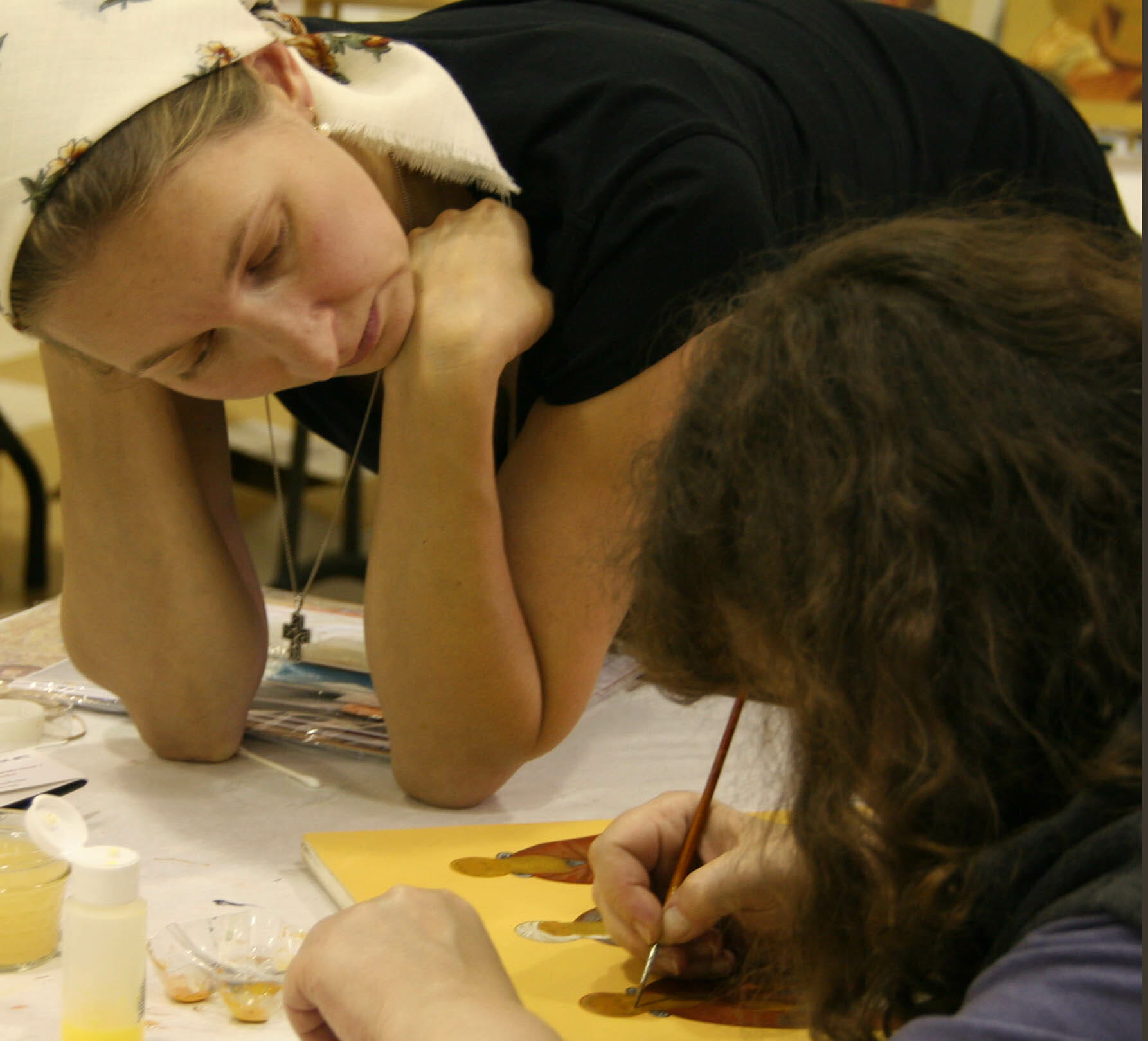
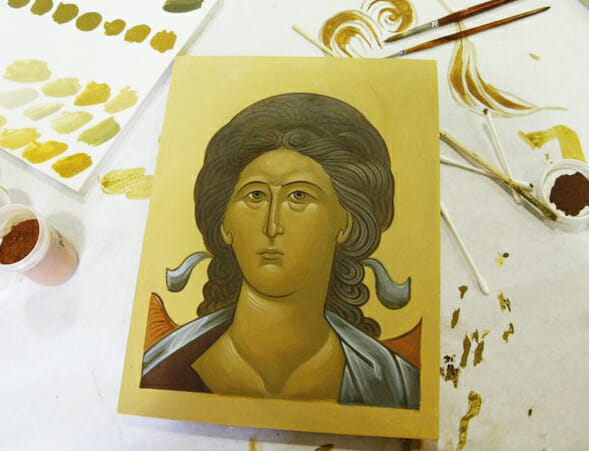
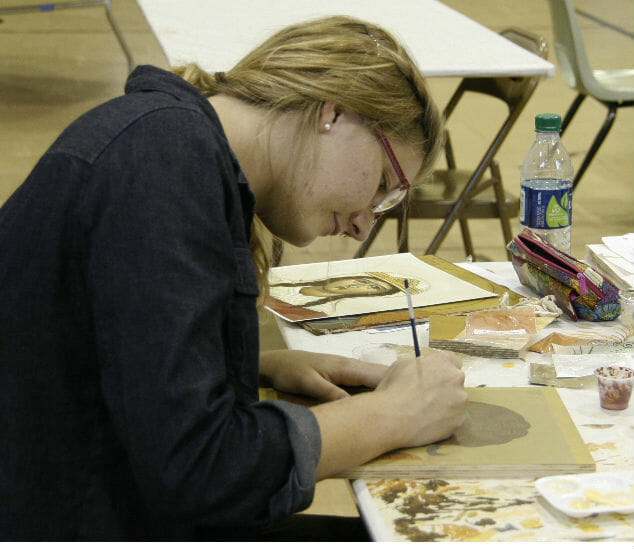
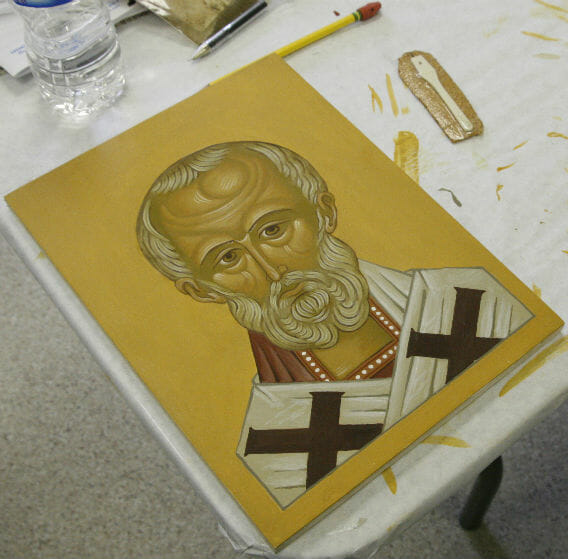
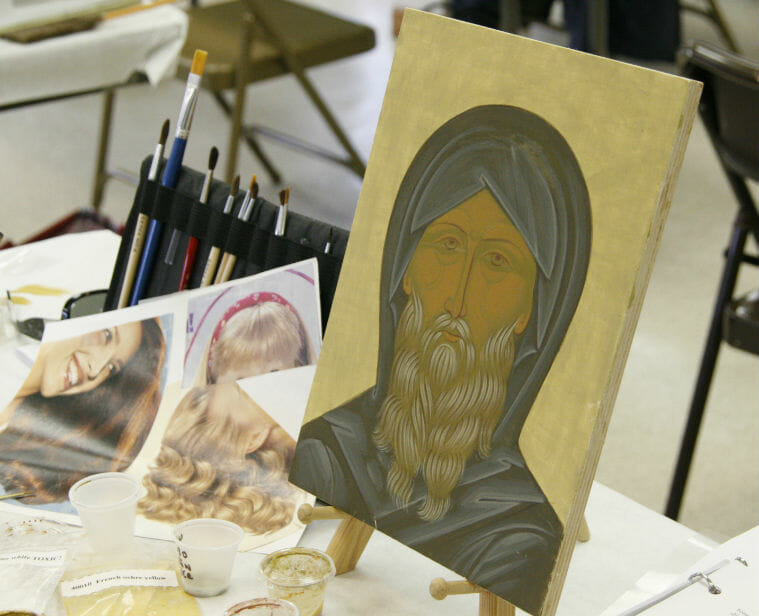
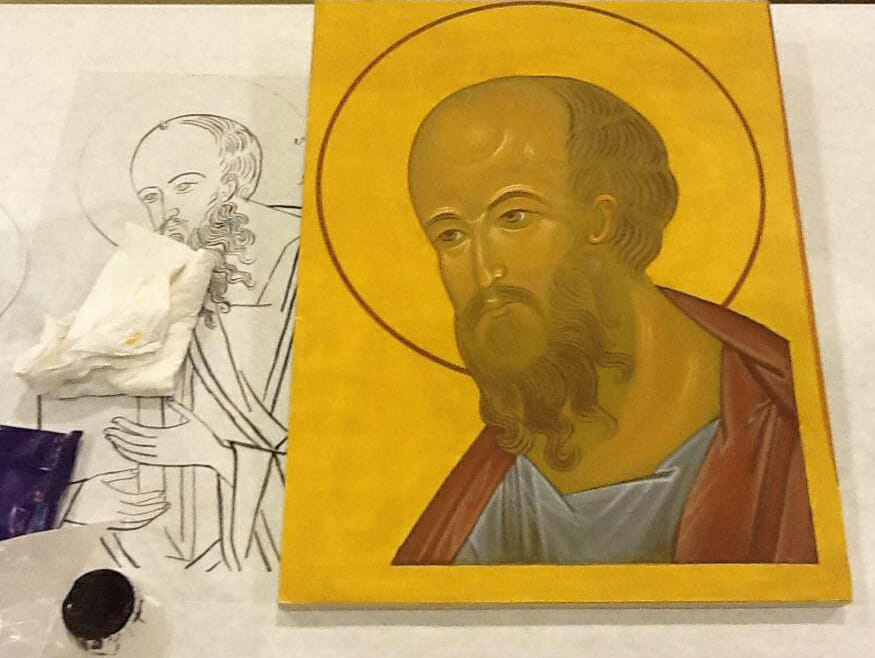
Beautiful article Mary. I took Hexaemeron this year and learned so much but did not at the time understand why our teachers spent so much time with some of the student working on their icons. How were they going to learn? Now I see why!!! Now I understand – They could not allow us to fail. It was their duty. From the very beginning some were absolutely destined to fail, but all left with beautiful icons. I look forward to attending another workshop with Hexaemeron. Team Ksenia, Anna and Marek are an open book and allowed questions to asked at any time even during breakfast lunch and dinner. Unlike other workshops I have attended where you were made to feel that some questions you might have could not be answered, they were the ICONOGRAPHERS secrets.
Great Article Mary, I look forward to hopefully seeing you again.
“Team Ksenia, Anna and Marek are an open book and allowed questions to asked at any time even during breakfast lunch and dinner.” How true, Vivian!
Hi Mary, Thank you for tackling this topic – why we work on our students’ icons. In art school, this would have been frowned on as interfering with individual expression. But the work of an iconographer is a tool in the service of something bigger. The self is only one piece (since it is never mechanical work) and not the most important one. It’s not my icon, your icon, but the Church’s icon.
As teachers, Ksenia knows that we have to help, and recommends that when students return home after the workshop to write the same icon again, entirely by themselves. Part of the problem, too, is the constraints of time in a week’s workshop.
When a student comes to a workshop out of sincere curiosity, uncertainty, or is interested in making only one icon, I don’t worry how much of my hand I add to their work. If and when someone commits to a lifetime of practice and discipline, it’s time to work in a different way. That’s when we pull back and keep our distance. It’s a way to provoke them into putting themselves deeper into the work. But most people, when they come to iconography, have no idea how much (and what kind of) hard work it will be. I know I didn’t.
Recently, in one of my student’s work, I saw I was giving too much help. It bothered me; the student was not accepting the challenges that the icon demanded. To circumvent this, I made my student first make a separate practice panel – it’s like a laboratory where all uncertainties can be worked out. When we have an extended time of many many weeks to work like this, I will help there, but not on the icon itself. Most of my regular students work this way now, it gives them freedom to experiment and try. As well as fail and try again. I wish I could claim this method as my own inspiration, but Ksenia taught me like this.
After a while, it is a relief to hear a student say, “don’t do it for me anymore, show me so I can do it for myself” It’s out of self-reliance and a need to know- a sign that says, I’m finally willing to wrestle through the problem.
But as a teacher, especially with new students, you can sense immediately when that won’t work, or when that demand is made simply out of pride (as an artist, I know something about this). The only way they can understand is by watching you analyze the problem, think through it and perform the act. There’s no other way to do it. Some information is conveyed passively.
As student, I will never forget many silent, inadvertent lessons like this. I had hit a wall and had no idea what to do. I am sure Ksenia was not thinking she was teaching me anything; she was just being herself and working. Like the way her knuckles bent and straightened out at certain points of a curve as her brush painted curls- how much paint she loaded on her brush- how wet or dry it was – how much pressure she applied – did she move her whole arm, or just her wrist? I also remember thinking, I will never be able to do this. “It will take time, Marek” Ksenia would say.
After she saw that I wanted to go deeper into the work, Ksenia hardly ever touched my work: but then, there was the next step in learning – every time I made a mistake, I had to scrape off everything to the bare gesso and begin from square one. After that I worked very cautiously, and hardly did anything without asking for advice first. Eventually, I could do it on my own.
Yeah, I was trying to say all that, Marek; things I’ve learned over the years from eavesdropping on thousands of very similar conversations between students and teachers, but you gave flesh to my ramblings. Thank you.